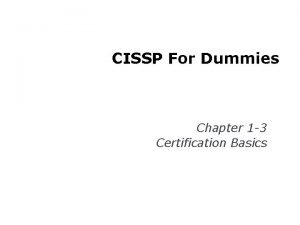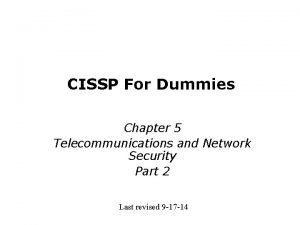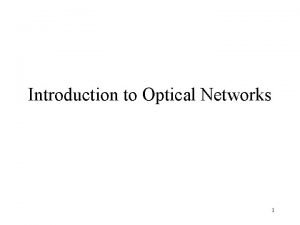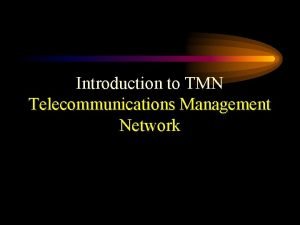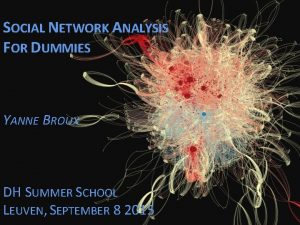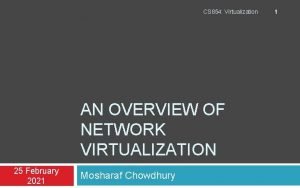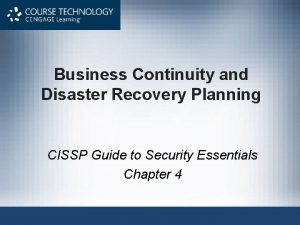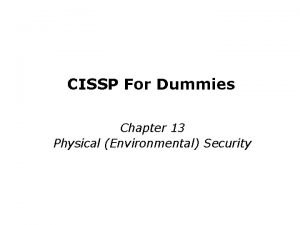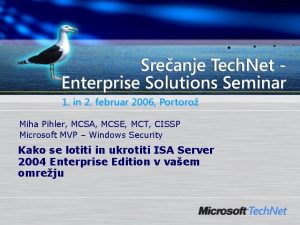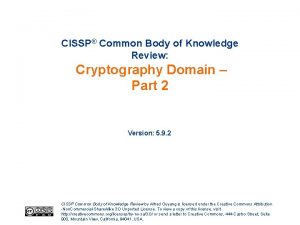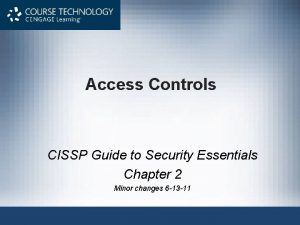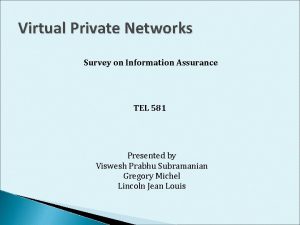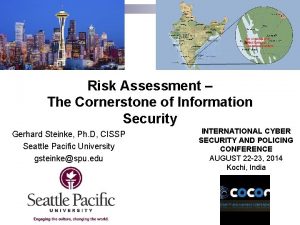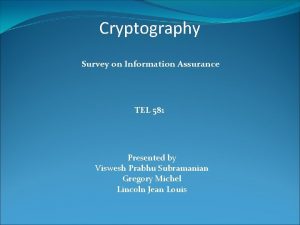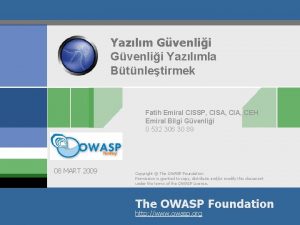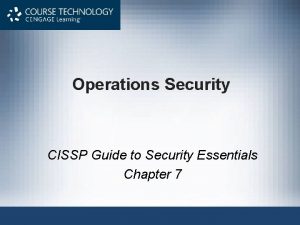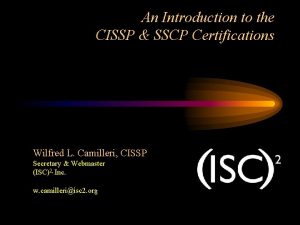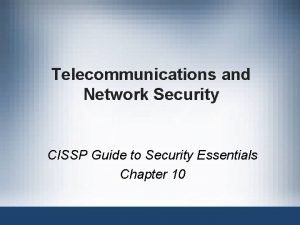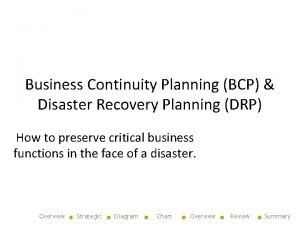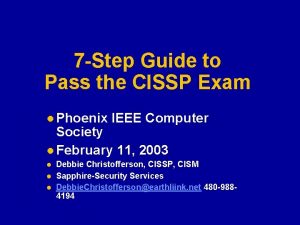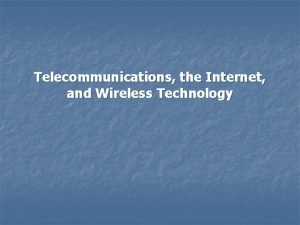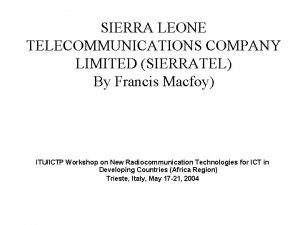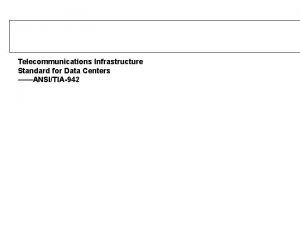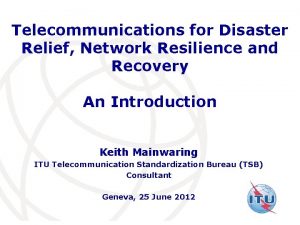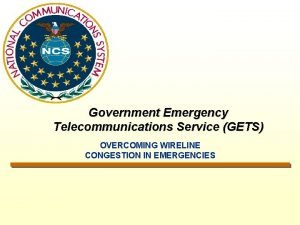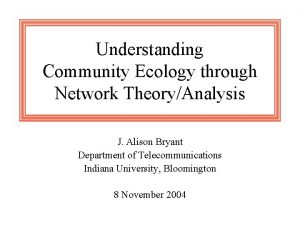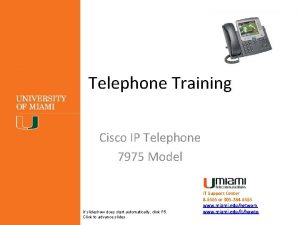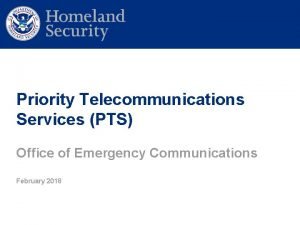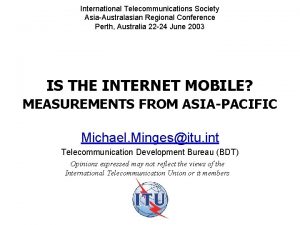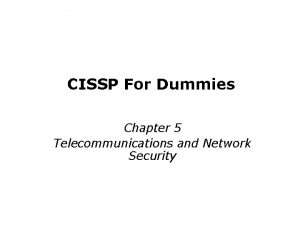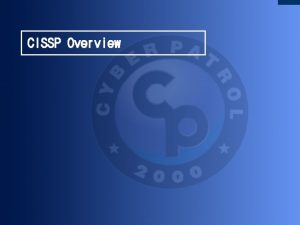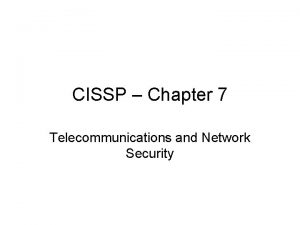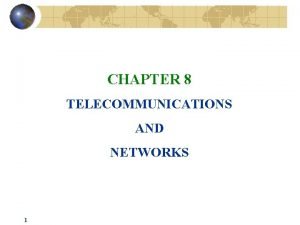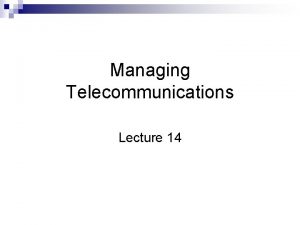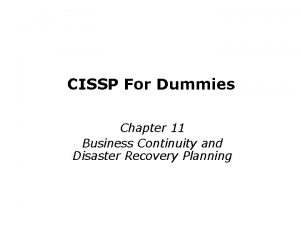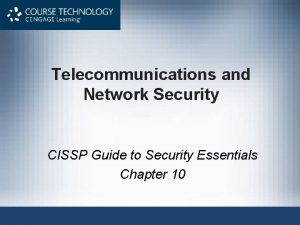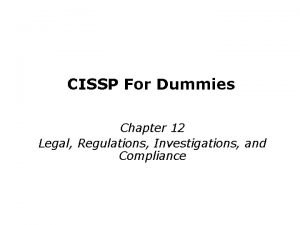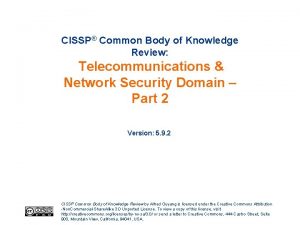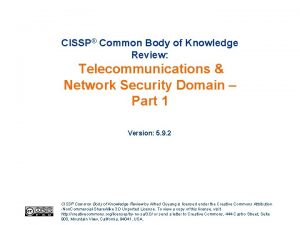CISSP For Dummies Chapter 5 Telecommunications and Network

































































- Slides: 65

CISSP For Dummies Chapter 5 Telecommunications and Network Security Part 2 Last revised 9 -17 -14 Last updated 11 -26 -12

Topics • TCP/IP Model • Securing wired and wireless networks • Securing e-mail, Internet, Fax, and phone lines • Network attacks and countermeasures – In other words, Net+ or CCNA

The TCP/IP Model

TCP/IP Model • Developed by US Do. D • Four layers – Application – Transport – Internet – Network Access (or Link)


Network Security

Firewalls • Hardware firewalls – Protect a whole network • Software firewalls – Typically protect only a single host – Dependent on OS • Images from www. scalenetwork. com and reneedasaro. com

Firewall Types • Packet filtering • Circuit-level gateway • Application-level gateway

Packet Filtering • Most basic and inexpensive firewall • Allows or denies traffic based on Access Control Lists (ACLs) using – TCP or UDP header – ICMP header – IP header – Traffic direction • Operate at OSI layers 3 or 4

Packet Filtering • Advantages – Inexpensive—can be implemented within a router – Fast and flexible – Transparent to users • Disadvantages – – – Examines only headers No protection from IP or DNS spoofing No support for strong user authentication ACLs may be difficult to configure and maintain Limited logging ability

Dynamic Packet Filtering • Dynamic modification of firewall rules • Context-based access control – Creates dynamic rules for sessions as they are established

Circuit-Level Gateway • Operates at OSI layer 5 (Session) • Maintains state information about established sessions • Once a session is established, a tunnel or virtual circuit is established • Packets flow freely through the tunnel without further inspection

Circuit-Level Gateway • Advantages – Speed – Support for many protocols – Easy maintenance • Disadvantages – Dependent on trustworthy users and hosts, since no further inspection of tunneled traffic is done – Limited logging

Stateful Packet Inspection • Developed by Check Point (link Ch 5 a) • Gathers packets at layer 3 • Analyzes those packets at higher layers, up to layer 7 • Also includes context

Application-Layer Gateway • Operates at OSI Layer 7 • The most secure • Operates as a proxy server—breaks the clientserver connection

Application-Layer Gateway • Advantages – Internal network is concealed from Internet – Can implement strong user authentication in applications • Disadvantages – Slow: every packet must be inspected up to layer 7 – Must be tailored to specific applications • Can be difficult to maintain or update

Firewall Architectures • • Screening Router Dual-homed Gateway Screened-host Gateway Screened Subnet

Screening Router • Most basic firewall architecture • A router with ACLs sits between the trusted and untrusted networks – Images from Wikipedia & Iconspedia Trusted Untrusted

Screening Router • Advantages – Transparent – Simple to use and inexpensive • Disadvantages – Limited logging – No user authentication – Difficult to conceal internal network structure

Dual-homed Gateway (or Bastion Host) • Gateway has two NICs • Acts as a proxy server, may require user authentication – Images from Wikipedia & Iconspedia Trusted Untrusted Gateway

Dual-homed Gateway • Advantages – Fail-safe: if it fails, it allows no access – Internal network structure is masked • Disadvantages – May inconvenience users by requiring authentication – Proxies may not be available for some services – May slow down network

Screened-host Gateway • Gateway protected by screening router – Images from Wikipedia & Iconspedia GATEWAY Trusted Untrusted

Screened-host Gateway • Advantages – Distributes security between two devices – Transparent outbound access – Restricted inbound access • Disadvantages – Less secure because screening router can bypass the bastion host for certain trusted services – Masking internal network structure is difficult – Multiple single points of failure

Screened-subnet • Most secure • Implements a De. Militarized Zone (DMZ) GATEWAY Trusted DMZ Untrusted

Screened Subnet • Advantages – Transparent to end-users – Flexible – Internal network structure can be masked – Defense in depth • Disadvantages – More expensive – More difficult to configure, maintain, and troubleshoot

Intrusion Detection and Prevention Systems (IDS, IPS, IDPS) • IPS or IDPS or Active IDS – Automatically blocks attacks in progress – Must be placed inline at a network boundary – Single point of failure and high-value target – Can deny access to legitimate users – May create a Do. S if the IPS is attacked • Passive IDS – Detects attacks and alerts operator – Does not block attacks

Network-based and Host-based IDS • Network-based IDS – NIC sniffing in promiscuous mode on a monitor port • Host-based IDS – Requires agents on each monitored system – Agents write data to log files, and/or trigger alarms

Knowledge-based IDS (aka Signature-based) • Uses a database of attack signatures • Advantages – Low false-alarm rate – More standardized & easily understood than behavior-based IDS • Disadvantages – Signature database must be updated – New attacks may not be detected

Behavior-based IDS (aka Statistical Anomaly-based) • References a baseline of normal system activity • Deviations from normal activity trigger alarms • Advantage – Adapt to new attacks • Disadvantages – Higher false alarm rate – Inability to adapt to rapidly-changing legitimate usage patterns

Remote Access

Remote Access Security Methods • Restricted allowed addresses – Only certain IP addresses allowed in – Identifies node, not user – Can be spoofed • Caller ID – Can be spoofed • Callback – Requires RAS server to call back at known phone number – Can be defeated by call forwarding

Remote Access Protocols • RAS (Remote Access Server) uses PPP (Point-to -Point Protocol) to encapsulate packets • Three authentication protocols – PAP (Password Authentication Protocol) sends passwords in cleartext – CHAP (Challenge Handshake Protocol) sends a hash of challenge + shared secret • MS-CHAP and MS-CHAPv 2 are Microsoft's versions – EAP (Extensible Authentication Protocol)

EAP Authentication – MD 5 -challenge (not strong, link Ch 5 m) – S/Key (a one-time password system, link Ch 5 l) – Token, card – Digital certificates – More options • Commonly used on wireless networks

RADIUS (Remote Authentication Dial-In User Service) – Open source – Uses UDP – Provides authentication and accountability – Uses PAP or CHAP • Diameter – Improvement on RADIUS – Uses TCP – Supports IPSec or TLS

TACACS+ Terminal Access Controller Access-Control System • • Developed by Cisco Replaces the older TACACS protocol TCP 49 Supports many authentication methods – PAP, CHAP, MS-CHAP, EAP, Token cards, Kerberos, et.

VPNs (Virtual Private Networks)

VPN Tunnel • A secure tunnel connecting two endpoints via an insecure network, usually the Internet • Client-to-VPN Concentrator • Client-to-Firewall • Firewall-to-Firewall • Router-to-Router

VPN Protocols • • • PPTP (Point-to-Point Tunneling Protocol) L 2 F (Layer 2 Forwarding) L 2 TP (Layer 2 Tunneling Protocol) IPSec (Internet Protocol Security) SSL (Secure Sockets Layer)

PPTP (Point-to-Point Tunneling Protocol) • Developed by Microsoft • Uses PPP authentication methods – PAP, CHAP, EAP – Broken (link Ch 5 b)

L 2 F (Layer 2 Forwarding) • Developed by Cisco • Does not provide encryption, relies on a higher-level protocol to do that

L 2 TP (Layer 2 Tunneling Protocol) • Provides transport, not encryption • Commonly used with IPSec • Supports PPP authentication, RADIUS, TACACS, smart cards, and one-time passwords

IPSec (Internet Protocol Security) Open standard Most popular and robust VPN Considered very secure Transport mode: only data is encrypted Tunnel mode: whole packet encrypted AH (Authentication Header) provides integrity, authentication, and non-repudiation • Encapsulating Security Payload (ESP) provides confidentiality and limited authentication • • •

SA (Security Association) • Each pair of hosts communicating in an IPSec session must establish a SA • SA is a one-way connection between two parties • Two SAs are required for two-way communication • Each SA supports only one protocol (SA or ESP)

SA (Security Association) • An SA has three parameters that uniquely identify it • Security Parameter Index (SPI) – 32 -bit string in the AH or ESP header • Destination IP Address • Security Protocol ID – AH or ESP

Key Management in IPSec • Done with Internet Key Exchange (IKE), which uses three protocols – Internet Security Association and Key Management Protocol (ISAKMP) – Secure Key Exchange Mechanism (SKEME) – Oakley Key Exchange Protocol

SSL (Secure Sockets Layer) • Operates on upper layers of the OSI model (layers 5, 6, or 7) – References vary, but they all agree the textbook is wrong placing it at layer 4 • SSL VPNs require no client software, other than a normal Web browser • User gets access to a single application, not the whole private network – Not all applications work over SSL VPNs

WLAN Security

Access Points (APs) • Omnidirectional – Most common type – Short antennas – Transmit and receive in all directions around a horizontal axis • Parabolic (dish antennas) – One direction • Sectorized and Yagi are other directional antennas

AP Modes • Root mode – Default for most APs – aka Infrastructure mode • Repeater mode – Doesn't connect directly to wired network – Extends range of a WLAN • Bridge mode – Connecting two wired LANS via a wireless link – Rare

WLAN Security • SSID (Service Set Identifier) – Name of the network, e. g. "CCSF Wireless" – Broadcast by AP in Beacon Frames – Included in frames in cleartext • WEP (Wired Equivalent Privacy) – Weak, broken, encryption method – Uses 40 -bit or 104 -bit key & 24 -bit initialization vector – In common use but insecure

WPA (Wi-Fi Protected Access) • WPA uses TKIP (Temporal Key Integrity Protocol) • WPA & WPA 2 support EAP extensions – EAP-TLS (Transport Layer Security) – EAP-TTLS (Tunnelled Transport Layer Security) – PEAP (Protected EAP) • WPA 2 uses Counter Cipher Mode with Block Chaining Message Authentication Code Protocol or CCMP instead of TKIP

WPA Security • WPA and WPA-2 are both strong, unless the passphrase can be guessed • Wi-Fi Protected Setup (WPS), however, ruins it all by reducing WPA and WPA 2 down to an 8 bit number with only 10, 500 possible values which can be brute-forced

E-mail, Fax, & Phone Security

Email Security • SMTP (Simple Mail Transfer Protocol) servers send email – Usually without verifying the sender's address – This leads to Spam • Real-time Blackhole Lists – Block open relays and other sources of spam – Every organization must protect their email server from being used by spammers to keep off the blackhole lists

Risks from Spam • Missing important emails • Malware in attachments or links • Phishing and pharming scams

Web Security

HTTP & HTML • HTTP (Hypertext Transfer Protocol) is used to send Web pages • The pages are written in HTML (Hypertext Markup Language) • Attacks: – Script injection – Buffer overflow – Denial of Service

Fax Security • Messages may be mishandled at recipient station • Security practices: – Cover pages with proper routing & classification markings – Place fax machines in secure areas – Use secure phone lines – Encrypt fax data

PBX, POTS, & Vo. IP Security • PBX (Private Branch Exchange) switches manage phone calls within a company • POTS (Plain Old Telephone Service) • Vo. IP (Voice over Internet Protocol) • Attacks – Personal use of company resources – Caller ID spoofing & hiding

Network Attacks and Countermeasures

Bluejacking & Bluesnarfing • Bluejacking – Sending spam bluetooth messages • Bluesnarfing – Stealing personal data, such as contacts, from a bluetooth-enabled phone – Phone serial numbers can be stolen this way and used to clone your phone

Smurf & Fraggle • Smurf attack – Sends pings to a broadcast address – Target is in source IP of pings – Target gets many ECHO REPLY packets • Fraggle attack – Sends UDP packets to port 7 (Echo) or 19 (Chargen) – Replies flood target, like the Smurf attack

Packet Floods • SYN Flood – Most effective – Burdens server waiting for SYN/ACK (half-open connections) • UDP Flood • ICMP Flood

Session Hijacking • Traditional method – Predicting SEQ numbers – Sending spoofed packets to replace packets in a session after login is complete • Modern method – Sniff authentication cookies – Access to Facebook, Gmail, etc.

Teardrop Attack • Length and Fragmentation Offset fields in IP packets – Intended to allow large packets to be fragmented & re-assembled – Malicious values in these packets cause fragments to overlap – Crashes vulnerable systems
 Cissp chapter 1
Cissp chapter 1 Telecommunication for dummies
Telecommunication for dummies Telecommunications for dummies
Telecommunications for dummies Gravity for dummies and dummies for gravity equations
Gravity for dummies and dummies for gravity equations Telecommunication network architecture
Telecommunication network architecture Tmn system
Tmn system Network analysis for dummies
Network analysis for dummies Virtualization
Virtualization How often should a business continuity plan be tested cissp
How often should a business continuity plan be tested cissp Soc cissp
Soc cissp Cissp physical security
Cissp physical security Bcp vs drp cissp
Bcp vs drp cissp Microsoft cissp
Microsoft cissp Snt cissp
Snt cissp Reference monitor cissp
Reference monitor cissp Cissp common body of knowledge
Cissp common body of knowledge Cots cissp
Cots cissp Types of security controls cissp
Types of security controls cissp Cissp
Cissp Cissp quantitative risk analysis
Cissp quantitative risk analysis Cissp
Cissp Fatih emiral
Fatih emiral Cissp guide to security essentials
Cissp guide to security essentials Shon harris cissp
Shon harris cissp Cissp exam cost philippines
Cissp exam cost philippines Cissp or sscp
Cissp or sscp Windsor castle postcode
Windsor castle postcode Cissp guide to security essentials
Cissp guide to security essentials Bcp vs drp cissp
Bcp vs drp cissp Boson cissp promo code
Boson cissp promo code Data communication components
Data communication components Electronics and telecommunications research institute
Electronics and telecommunications research institute Telecommunications, the internet, and wireless technology
Telecommunications, the internet, and wireless technology What are wireless devices and the wireless revolution
What are wireless devices and the wireless revolution Telecommunication processors
Telecommunication processors A pioneer in the field of telecommunications
A pioneer in the field of telecommunications Project management telecommunications
Project management telecommunications Osha telecommunications standards
Osha telecommunications standards Sierra leone telecommunications company
Sierra leone telecommunications company Telecommunications act of 1996
Telecommunications act of 1996 Venture capital telecommunications
Venture capital telecommunications Telecommunications infrastructure standard for data centers
Telecommunications infrastructure standard for data centers Disaster recovery telecommunications
Disaster recovery telecommunications Rfp for telecommunications services
Rfp for telecommunications services Government emergency telecommunications service
Government emergency telecommunications service Telecommunications engineering
Telecommunications engineering Department of telecommunications
Department of telecommunications Department of telecommunications
Department of telecommunications French telecommunications equipment company
French telecommunications equipment company Digital telecommunications
Digital telecommunications Iu telecommunications
Iu telecommunications European telecommunications standards institute
European telecommunications standards institute Digital telecommunications
Digital telecommunications Government emergency telecommunications service
Government emergency telecommunications service International telecommunications society
International telecommunications society Wireless telecommunications industry analysis
Wireless telecommunications industry analysis Gts telecommunications
Gts telecommunications Fspos
Fspos Novell typiska drag
Novell typiska drag Nationell inriktning för artificiell intelligens
Nationell inriktning för artificiell intelligens Returpilarna
Returpilarna Varför kallas perioden 1918-1939 för mellankrigstiden?
Varför kallas perioden 1918-1939 för mellankrigstiden? En lathund för arbete med kontinuitetshantering
En lathund för arbete med kontinuitetshantering Särskild löneskatt för pensionskostnader
Särskild löneskatt för pensionskostnader Tidbok
Tidbok Sura för anatom
Sura för anatom
